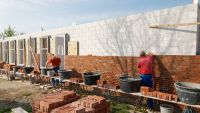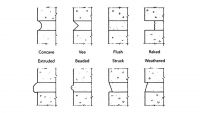International Building Code
By Jeffrey H. Greenwald, P. E.
In the year 2000 a new building code system will be in place throughout the United States, the International Building Code (IBC). With the implementation of this new code there will be a greater consistency for masonry design and construction provisions; there will be one set of code development hearings to monitor and participate in rather than three separate hearings each year; and it provides an opportunity for the masonry industry to present model building code provisions through a single forum, the Masonry Alliance for Codes and Standards (MACS).
Background
Up until the present, with the exception of several states and some large cities, the business of writing building codes has been handled by three model code organizations, the:
Building Officials and Code Administrators International (BOCA)
International Conference of Building Officials (ICBO)
Southern Building Code Congress International (SBCCI)
BOCA publishes the National Building Code (NBC). Its area of influence covers the northern states from the east coast to the Mississippi River. ICBO publishes the Uniform Building Code (UBC) in the area which extends from the Mississippi River to the West Coast. SBCCI publishes the Standard Building Code in the southern states extending from the East Coast westward through Texas. Some states, such as Oklahoma, have localities that recognize one or the other of two of the model codes; while in Texas all three codes can be found in use.
A few years back, an effort was undertaken to coordinate the provisions of the three code documents into a common format. As a result of this effort, code provisions can now be found in the same chapters of each model code. However, specific provisions in the three building codes are different. For example, the UBC has provisions for the strength design of masonry that are not found in the other two codes. Also, the NBC and the SBC refer to consensus documents for design and material standards, while the UBC maintains all these provisions in its three volumes. The former method is considered by most to be better for the industry and is the method adopted by the developers of the new code.
International Building Code
In 1994, the three model code organizations formed the International Code Council (ICC) to develop a single set of regulatory documents covering building, mechanical, plumbing, fire and related regulations. Its mission is to foster national unity to allow the construction industry to compete in an international setting. The mission adopted by the ICC reads as follows:
To promulgate a comprehensive and compatible regulatory system for the building environment through consistent performance-based regulations that are effective, efficient, and meet government, industry, and public needs.
The ICC has made substantial progress in its effort to publish this family of building codes. To date, the International Plumbing Code, the International Private Sewage Disposal Code and the International Mechanical Code have been published.
Additionally, the ICC has assumed responsibility for maintenance of the One and Two Family Dwelling Code and the Model Energy Code. The ICC has also established a schedule to develop an International Fire Code which is to be published in the year 2000.
BOCA, ICBO and SBCCI are beginning to phase out their separate codes, deferring to the ICC documents on plumbing, private sewage disposal and mechanical provisions.
As for Building Codes, ICBO has suspended the development of the UBC in order to focus on the International Building Code. The 1997 UBC, due to be published later this year, is expected to be the last edition of this code.
SBCCI has declared a moratorium on code changes for 1997, so no new changes will be accepted this year. This is a typical practice for the code organizations during a code publication year; the 1997 SBC will be published later this year. SBCCI will return to code development of the SBC in 1998.
On the other hand, BOCA will have code development cycles in 1997 and 1998 culminating in the publication of the 1999 National Building Code.
To follow the progress of the ICC and ensure masonry design and construction provisions are properly incorporated, a balance of masonry industry representatives have formed the Masonry Alliance for Codes and Standards (MACS). The Alliance is structured to serve the masonry industry as a coordinating forum for needed codes and standards development in the future.
MACS is committed to a pro-active position in the development of the International Building Code by a broad cross section of masonry industry representatives. MACs has developed a strategy for effectively positioning masonry provisions consistent with masonry's field performance and consistent with its properties documented in laboratory research.
This strategy has identified 18 topic areas, each requiring a specific plan of action. These actions are currently under development by the members of the Alliance. Topics being addressed include:
Construction, Empirical Masonry Design, Energy, Fire Safety, Fireplaces and Chimneys, Glass Unit Masonry, One and Two Family Dwelling - Foundations, One and Two Family Dwelling - Other, Prestressed Masonry Design, Quality Control/Quality Assurance, Seismic Design, Sound Transmission, Strength Design, Structural Forces, Working Stress Design - Unreinforced Masonry, Veneers, and Wind Design.
As the year 2000 approaches, MACS will continue to maintain a vigilant position through the development, adoption, and enforcement of the International Building Code.
About the Author
Jeffrey H. Greenwald, P. E. is the Codes Engineer for the National Concrete Masonry Association.


















